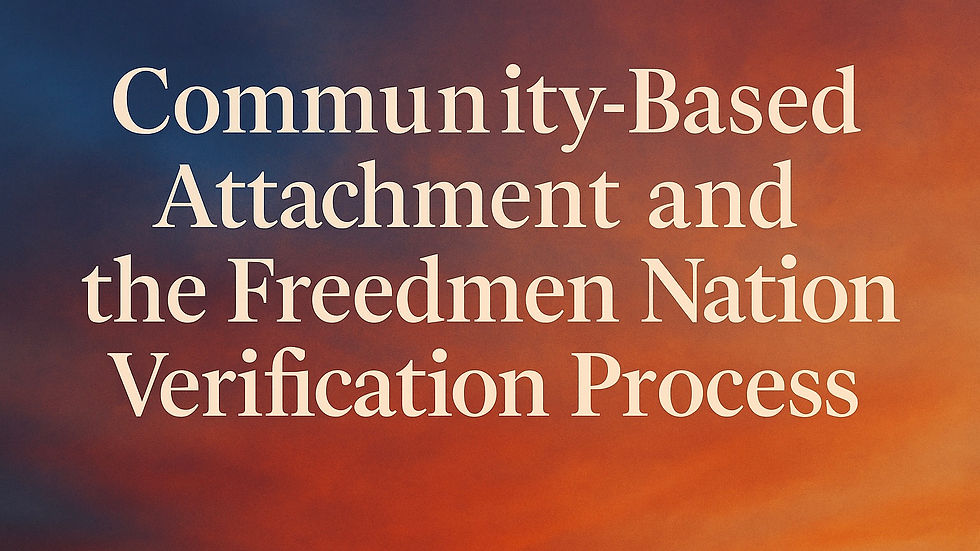Community-Based Attachment and the Freedmen Nation Verification Process
- Freedmen Nation
- 9 minutes ago
- 3 min read

Reclaiming Identity Beyond the Tribal Roll
For centuries, government records have defined “American Indian” narrowly—usually limited to citizens of federally recognized tribes. But U.S. federal definitions include another, often-overlooked pathway: community attachment. The Freedmen Nation was built on that principle.
Under the Office of Management and Budget’s Directive No. 15, which sets racial and ethnic standards for the Census and federal agencies, an American Indian or Alaska Native is:
“A person having origins in any of the original peoples of North and South America (including Central America) and who maintains tribal affiliation or community attachment.”
That second clause—community attachment—is the opening through which Freedmen successors, whose Indigenous ancestry was erased through slavery and reclassification, can lawfully restore their standing.
What “Community Attachment” Means
Community attachment does not depend on federal recognition, blood quantum, or enrollment cards.
It means belonging to a living, organized community that preserves, practices, and verifies cultural continuity with the original peoples of this land.
For the descendants of enslaved Indigenous Americans, tribal affiliation was deliberately broken by law.
Yet their communities survived—through family networks, Freedmen schools, mutual aid societies, churches, and land cooperatives—and now through the Freedmen Nation.
That survival is the proof of attachment.
Verification: The Freedmen Nation Approach
The Freedmen Nation Verification Department operates as the genealogical and cultural record-keeper for those reclassified ancestors. Each verification file includes:
Documentary lineage — census and death records from the 1800s–1900s listing ancestors as Colored, Negro, Mulatto, or Indian;
Historical residency — proof of family presence in U.S. territories before 1865;
Affidavit or oral history — affirming continuity of family identity; and
Community membership — confirmed through participation in Freedmen Nation programs and acknowledgment under the American Aborigine Declaration.
This system converts fragmented personal histories into a recognized communal record. It gives descendants the documentation needed to lawfully self-identify as American Indian (non-tribally affiliated)—the rightful classification for the Indigenous people of North America who were enslaved, freed, and renamed.
In Addition To: Why Death Certificates Matter
In addition to census and genealogical documentation, death certificates of ancestors born in the 1800s hold vital evidence of misclassification.
When an ancestor’s death record lists “Mulatto,” “Colored,” or “Negro,” it marks the legal moment when an Indigenous American lineage was reclassified into a foreign racial category.
These documents reveal:
The state and county where reclassification took place;
Family continuity across generations;
Birthplaces linking families to Indigenous regions of the United States before mass African importation; and
Witnesses and informants who belonged to Freedmen or Indigenous communities.
When added to a verification file, these certificates become documentary proof of forced racial reassignment—the very condition the Freedmen Nation exists to correct.
Each certificate strengthens the claim of American Indian (non-tribal) heritage and fulfills the community attachment clause of federal law by connecting the individual to a verified cultural community.
Why It Matters
Community-based attachment restores what racial classification took away: the right to name oneself according to one’s true origin and continuity.
By documenting reclassified Indigenous lines, Freedmen Nation members ensure that their families are no longer absorbed into foreign racial categories such as “Black” or “African American.”
The verification process is not about exclusion—it’s about accuracy and restoration.
It connects Freedmen to their rightful place as the original peoples of North America whose tribal ties were severed but whose lineage never disappeared.
A Living Record of Continuity
Every new verification adds another thread to the national record of the Freedmen story. Each documented ancestor—once called Colored, Negro, or Mulatto—becomes part of the collective evidence that Indigenous identity in America did not vanish; it was administratively buried.
By unearthing those records and linking them through community-based verification, Freedmen Nation transforms paperwork into proof—and misclassification into restoration.



Comments